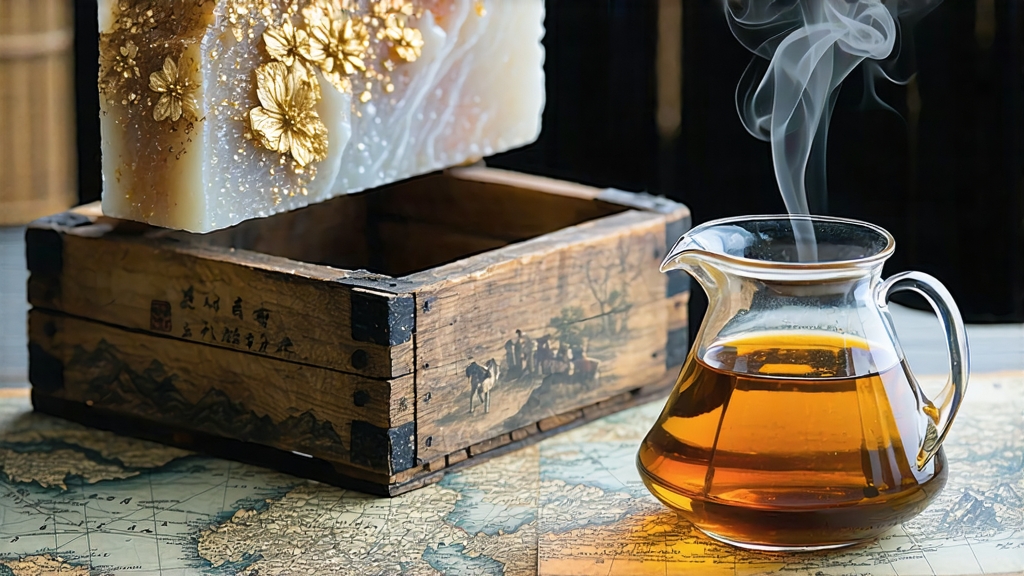
Among the six major chromatic families of Chinese tea, dark tea (heicha) is the most migratory; it once traveled farther than silk, porcelain or spices, and its most aromatic ambassador is Fu brick tea—Fuzhuan cha. Born in 1368 in Jingyang county, Shaanxi, Fu brick was invented to supply the tea-for-horse markets on the northwestern frontier of the Ming empire. Compressed into 2-kilogram bricks, it could survive the 3,000-km caravan journey to Tibet, Mongolia and Kazakhstan without molding or losing value. Along the way, something miraculous happened: inside the humid bamboo wraps a microscopic fungus, Eurotium cristatum, bloomed, painting the brick’s cross-section with golden speckles the nomads called “golden flowers” (jin hua). They believed the flowers aided digestion of yak butter and mutton fat, and soon “flower density” became the first known quality grading system based on microbial beauty rather than leaf appearance.
Fu brick is not a single cultivar but a processing style, so today it is produced in three provinces—Shaanxi (Jingyang), Hunan (Anhua) and Guangxi (Liuzhou)—each offering a terroir twist. Shaanxi bricks taste of wet earth, dried jujube and cooling camphor; Hunan versions add orchid honey and tobacco; Guangxi bricks carry the cane-sweet note of local wild maocha. Regardless of origin, all authentic Fu bricks must meet the national standard of ≥ 30,000 visible golden flower colonies per gram of finished tea, a density visible to the naked eye when the brick is snapped in half.
Crafting a Fu brick takes forty-five days and six precise stages. First, summer-picked large-leaf maocha (Yunwu, Fuding Da Bai or local Qinzhong varieties) is pan-fired at 280 °C to kill green enzymes, then rolled for 45 minutes to rupture cells. The key step is “wet piling” (wo dui): the damp leaves are heaped 70 cm high in a steamed room kept at 28 °C and 85 % RH for 12 hours, encouraging the rise of beneficial molds and yeasts. After the pile is broken and re-stacked three times, the semi-fermented tea is dried to 14 % moisture and stored for three months to stabilize aroma. Finally, the tea is steamed again, pressed into iron molds under 50-ton hydraulic pressure, and moved to the “flower-growing room” where bricks are spaced 2 cm apart on bamboo racks. For 15 days the room is kept like a sauna—26 °C, 80 % RH—while Eurotium cristatum infiltrates through pinholes left by the cloth wrappers, creating the signature golden grains. The slower the flowering, the smaller and brighter the flowers, and the more complex the final cup.
To brew Fu brick like a caravanner, you need only a knife, a kettle and patience. Insert the knife at a 30° angle along the natural fracture lines to pry off 5 g of tea, ensuring you capture both dark leaf and golden flecks. Rinse the chunk for five seconds with 100 °C water to awaken the spores, then steep in a 150 ml gaiwan using the “three-three” rhythm: infuse 3 seconds, discard; 3 seconds, discard; then steep 30 seconds for the first real infusion. Subsequent steeps lengthen by 10 seconds. The liquor blooms from pale apricot to deep ox-blood, releasing aromas of wet cave, buckwheat honey and a faint medicinal lift reminiscent of freshly split pine. On the tongue it is thicker than pu-erh yet cleaner, with a cooling ku-gan (bitter-sweet) finish that invites buttered Tibetan tsampa or simply solitude.
Professional cupping follows a darker protocol. Break 3 g of leaf into 5 mm fragments, place in a 250 ml white porcelain taster bowl, fill with boiling water and cover for 5 minutes. Evaluate “flower fragrance” first: bring the bowl to the nose, inhale sharply three times; a high-grade brick will exhale spore-laden notes of dried apricot, koji and river stone. Next, suck the liquor across the palate with a loud sip; look for three markers: (1) viscosity—measured by the